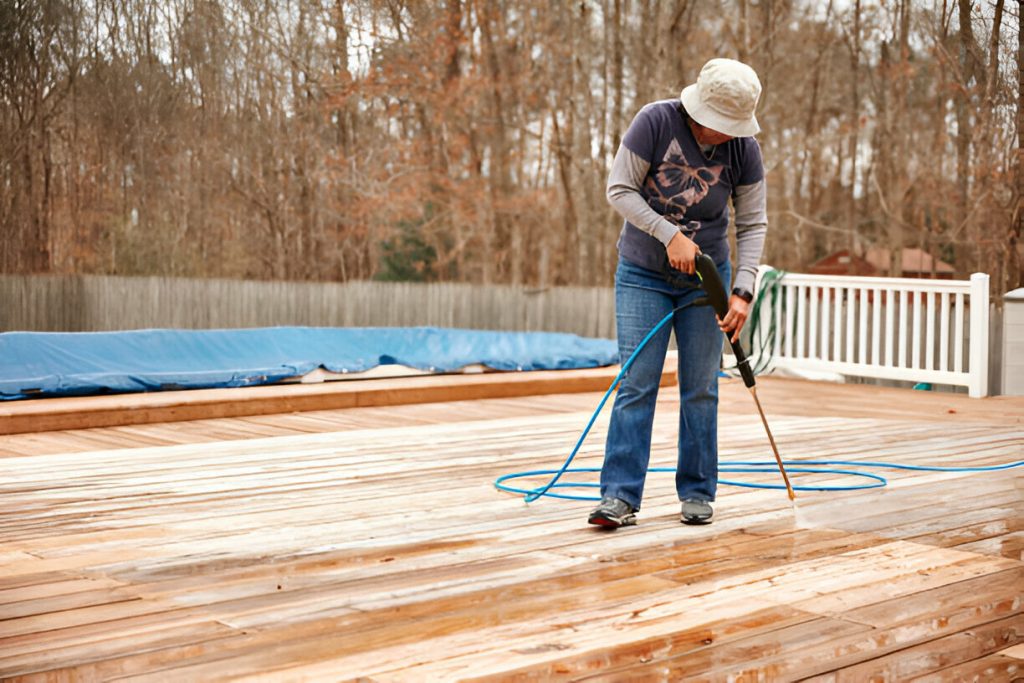Maintaining the appearance and integrity of your outdoor spaces is crucial for both aesthetic and practical reasons. Decks and patios, being significant investments in your home’s value and enjoyment, require regular upkeep. One common method for cleaning these surfaces is power washing, but is it safe for your deck or patio? In this blog, we’ll explore the safety considerations and best practices for power washing these areas.
Understanding Power Washing
Power washing, or pressure washing, utilizes a high-pressure water stream to effectively remove dirt, grime, mold, and mildew from surfaces. While it’s a powerful cleaning method, improper use can lead to damage, underscoring the importance of deck safety. Understanding surface materials, employing appropriate pressure settings, and implementing safety measures are crucial for maintaining a clean deck without compromising its integrity. Always prioritize deck safety to ensure long-lasting results and prevent potential harm.
Factors to Consider Before Power Washing
- Material of the Surface
- Wood Decks: Softwoods like cedar and pine are more susceptible to damage from high-pressure washing. Hardwoods like oak or composite decking are more durable but still require caution.
- Stone and Concrete Patios: Generally, these materials can withstand higher pressure, but older or damaged surfaces may be at risk of further deterioration.
- Condition of the Surface
- If your deck or patio has cracks, splinters, or is significantly aged, the high-pressure water can exacerbate these issues, leading to more extensive repairs.
- Appropriate Pressure Settings
- Using the correct pressure setting is crucial. For wood decks, a setting between 500-600 psi is typically sufficient. For harder surfaces like stone or concrete, you can use up to 3000 psi, but starting at a lower setting and increasing as needed is always safer.
- Distance and Technique
- Keeping the nozzle at a safe distance from the surface, usually around 12-18 inches, helps prevent damage. Moving the nozzle continuously to avoid concentrating the pressure on one spot is also important.
Safety Tips for Power Washing Your Deck or Patio
- Choose the Right Equipment
- Use a washer with adjustable pressure settings. If you’re inexperienced, renting a lower-powered machine might be a safer option.
- Select the Proper Nozzle
- Nozzles come in various angles, measured in degrees. A 25-degree nozzle is a good starting point for most deck and patio surfaces, offering a balance between pressure and coverage.
- Test in a Small Area First
- Always test the power washer on a small, inconspicuous area of the deck or patio to ensure it doesn’t cause damage.
- Use Detergents Wisely
- Specialized power washing detergents can help break down grime without the need for excessive pressure. Ensure the detergent is safe for your specific surface material.
- Protect Nearby Areas
- Cover nearby plants, furniture, and other items with plastic sheeting to protect them from debris and potential damage from the high-pressure spray.
- Follow Up with Sealing or Staining
- After power washing, allow your deck or patio to dry completely, then consider applying a sealant or stain to protect the surface from future damage and maintain its appearance.
Alternatives to Power Washing
If you determine that power washing might be too harsh for your deck or patio, consider alternative cleaning methods:
- Soft Washing: This technique uses low pressure combined with specialized cleaning solutions to remove dirt and mildew without the risk of damage.
- Hand Scrubbing: For smaller areas or delicate surfaces, manually scrubbing with a brush and gentle detergent can be effective.
Conclusion
Deck safety is paramount when power washing. Understanding your surface, using correct pressure settings, and taking precautions ensure a clean space without damage. Assess your deck’s condition and seek professional help if uncertain. Prioritize safety to maintain your deck’s longevity and appearance.
Maintaining your outdoor living areas not only enhances their appearance but also prolongs their lifespan, making them enjoyable spaces for years to come.

